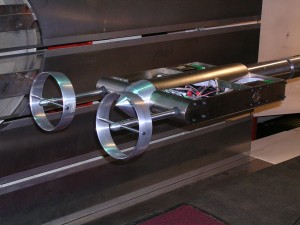 The CSIR has a globally recognised capability in aeroelasticity (flutter) that includes ground vibration testing, flutter excitation and flutter flight testing.
The CSIR has a globally recognised capability in aeroelasticity (flutter) that includes ground vibration testing, flutter excitation and flutter flight testing.
Flutter is a very dangerous dynamic instability that all aircraft can encounter. Flutter is driven by mass and stiffness distribution in the aircraft structure, combined with aerodynamic characteristics. Changes to those characteristics due to the addition or removal of mass can cause flutter. Such a situation can be caused by the addition (or removal) of a store (weapon, tank, bomb) to an aircraft wing. Flutter can be caused by incorrect mass balancing of a control surface. Flutter can be caused by flying in a part of the flight envelope that has not been verified to be flutter free. It is essential that the aeroelastic properties of all new aircraft or new aircraft/store configurations be evaluated so that flutter does not occur.
The CSIR provides services in all three phases of the flutter clearance process:
• Phase 1 – Ground vibration testing and modal analysis. During this phase the modal parameters of the aircraft/store combination are determined by performing a Ground Vibration test (GVT) and, by performing a modal analysis, extract the modal parameters (resonant frequency, structural damping and modeshape). The modal parameters can also be obtained from a FEM model if this is available.
• Phase 2 – Flutter prediction. The unsteady aerodynamic loads that would act on the aircraft if it were to oscillate in each of its natural modes, are calculated. The load distributions are then integrated with the modal displacements as weighting functions to obtain the generalised unsteady aerodynamic forces. These forces scale with dynamic pressure and are non-linear functions of Mach number and reduced frequency. The generalised unsteady aerodynamic forces, together with the modal parameters of mass, damping ratio and natural frequency are used to construct the equations of motion. The solution of the equations of motion yields the modal frequencies and damping ratios as a function of speed and altitude over the flight envelope. Negative damping values indicate growing oscillations, i.e. flutter.
• Phase 3 – Flutter Flight Testing. During this phase the aircraft is fitted with the store/s as tested during the GVT and a selected number of accelerometers are fitted to the aircraft. A Flutter Excitation System (FES) can be fitted to the aircraft to induce the structure’s natural frequencies. A telemetry system is capable of transmitting the accelerometer responses to a ground station. These signals can then be analysed by the CSIR operators and the modal parameters can be extracted. By monitoring the damping trend and frequency the flutter speed can be calculated. By flying at different speeds and altitudes the complete flight envelope can be tested and the aircraft/store combination can be declared flutter free (within this flight envelope).
Enquiries:
John Morgan
Telephone number: 012 841 2738
Email: JMorgan@csir.co.za
Enquiries:
Kimal Hiralall
Telephone number: 012 841 3187
Email: KHiralall@csir.co.za
